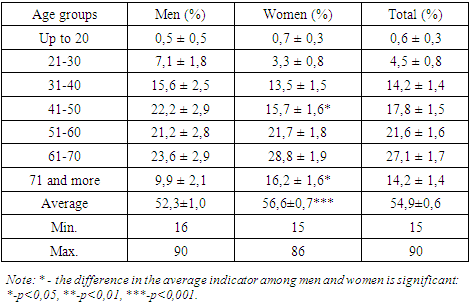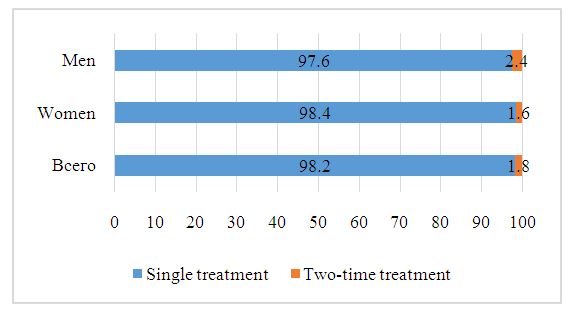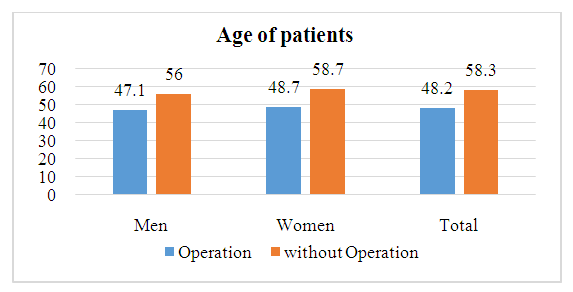Bahrom M. Mamatkulov, Dilorom A. Umurzakova
School of Public Health, Tashkent Medical Academy, Uzbekistan
Correspondence to: Bahrom M. Mamatkulov, School of Public Health, Tashkent Medical Academy, Uzbekistan.
| Email: |  |
Copyright © 2024 The Author(s). Published by Scientific & Academic Publishing.
This work is licensed under the Creative Commons Attribution International License (CC BY).
http://creativecommons.org/licenses/by/4.0/

Abstract
There are a number of theories explaining the development of osteochondrosis of the spine. In general, the causes of its occurrence may be internal (genetic or biomedical) or external (exogenous), as well as socio-hygienic factors. First of all, they are determined by the conditions of residence and work, as well as the specifics of work. Currently, various methods of treating osteochondrosis are used, which include surgical and conservative methods. The great importance of the problem of conservative treatment can be explained by the fact that any surgical intervention, whether surgical or not, takes place with an impact on one or more vertebral segments, while the degenerative-dystrophic process develops in all parts of the spine.
Keywords:
Osteochondrosis, Back pain, Risk factors, Hospitalized incidence, Hospitalized patients
Cite this paper: Bahrom M. Mamatkulov, Dilorom A. Umurzakova, Features of Hospitalized Incidence of Osteochondrosis of the Spine, American Journal of Medicine and Medical Sciences, Vol. 14 No. 7, 2024, pp. 1839-1843. doi: 10.5923/j.ajmms.20241407.24.
1. Introduction
Osteochondrosis is a multifactorial degenerative disease of the musculoskeletal system, which primarily affects the intervertebral discs and, secondly, other parts of the spine, the musculoskeletal system and the nervous system [1]. The great interest of doctors of various specialties in OS (osteochondrosis of the spine) is due to the extreme prevalence of the disease worldwide [2,3,11]. Screening X-ray studies show that the first signs of degenerative-dystrophic diseases of the spine in the form of a decrease in the height of the intervertebral spaces, which are the first signs of OS, begin to appear at the age of 6 years. [4] The significance of the disease is due to its prevalence among patients of working age (45-60 years), as a result of which there are significant economic losses (insurance payments and reduced labor efficiency) [5,6,12]. In people over 50 years of age, the pathology of the musculoskeletal system occupies a leading place in the structure of general morbidity. OS with spondylogenic pain syndrome is the second most common reason for going to a doctor after respiratory diseases and the third most common reason for hospitalization [7,8]. Thus, the prevalence of OS reaches the size of a pandemic and is a serious medical and socio-economic problem in developed countries [9,10]. At the same time, timely detection, treatment and rehabilitation are extremely important for improving the quality of life and improving the medical and social prognosis of patients with osteochondrosis of the spine.
2. Aim
To study age and gender characteristics, social status and occupation in hospitalized patients as risk factors for the development of spinal osteochondrosis.
3. Materials and Methods
To study age and gender characteristics, social status and occupation as risk factors for the development of spinal osteochondrosis in hospitalized patients, 663 case histories of patients of the department of vertebrology with a diagnosis of OS were studied in the archive of the Republican Specialized Scientific and Practical Medical Center of Traumatology and Orthopedics. The analysis of statistical data was carried out in the Statistica 10.0 application software package. Statistical data are presented in the form of arithmetic mean and standard deviation (M ± σ) or percentage (%). When comparing qualitative features, the criterion χ2 was calculated. The differences were considered statistically significant at p<0.05.
4. The Results and Their Discussion
An initial study of the clinical and anamnestic data of patients, as well as data from the medical histories of patients treated at the Department of Vertebrology of the Republican Specialized Scientific and Practical Medical Center of Traumatology and Orthopedics, showed that in total of 663 patients treated in 2023, men accounted for 32.0±1.8%, and women - 68.0±1.8%.The average age in the studied groups of patients was 54.9±0.6 years (min - 15, max – 90). The average age of men was 52.3±1.0 years (min - 15, max – 90), and women - 56.6±0.7 years (min – 15, max-86). The average age of women was 4.3 years higher than that of men (P<0.001) (Table 1).Table 1. Age data of patients
 |
| |
|
When analyzing by age groups, it was found that the proportion of patients under the age of 50 among men is 45.3±3.4%, and at the age of 51 years and older - 54.7±3.4%. The proportion of patients under the age of 50 among women was lower than among men, and amounted to 33.3±2.2% and 66.7±2.2%, respectively (p<0.01). This can be explained by the fact that occupational factors have a great impact on young men, as well as changes in metabolism after menopause in women. Among women aged 71 years and older, it was almost 2 times more than in the male group (p<0.01).The average stay of patients with osteochondrosis in the department of vertebrology was 6.0±0.1 days (5.7±0.2 days for men and 6.6±0.1 days for women). It was found that the average duration of treatment in women lasts almost 1 day longer than in men (p<0.001). Correlation analysis of the data showed that the age dependence on the duration of treatment has a weak direct correlation between men (r=0.27) and women (r=0.29).Among the hospitalized patients, those who live in the city predominate. This can be explained by the sedentary lifestyle and sedentary position during work of patients living in cities. There was no statistically significant difference between women and men by place of residence (in Fig. 1).  | Figure 1. The structure of patients by place of residence |
Depending on the type of activity, the hospitalized patients were divided as follows: 40.4±2.1% of patients were pensioners. Among the most common cases among men, 20.4±3.1% were unemployed, 36.5±3.7% were retired and 26.3±3.4% were employed. There were no unemployed women, which can be explained by the fact that unemployed women were noted as housewives. 37.6±2.5% of women were housewives, and 42.2±2.6% were pensioners. It was noted that there were more teachers among women than men, and there were more workers among men than among women (p<0.05) (Table 2).Table 2. Distribution of patients with OS according to gender and occupation (%)
 |
| |
|
96.7±1.2% of men and 91.3±1.3% of women arrived for treatment without referral from medical institutions. The number of hospitalized patients with OS in the direction of medical institutions was 3.3±1.2% among men, and 8.9±1.3% among women, which is 2.7 times more than in men (p<0.01).Planned hospitalization of patients with OP is almost 4 times less than unplanned ones. There was no statistically significant difference between the groups in this indicator (Fig. 2). | Figure 2. Inpatient treatment of patients (%) |
When analyzing the average duration of the disease at the time of admission, we obtained the following results. According to the duration of the disease, patients do not obey a certain law. However, it can be emphasized that almost 1/3 of the total number of patients (31.4±1.8%) are in the period 4-5 years from the onset of pathological disorders, although the range varied significantly – from a couple of weeks to 32 years. Among men, the number of patients increased in accordance with the duration of the disease, and most of all accounted for patients who were ill for 5 years (17.0±2.6%), and subsequently the number of patients decreased with increasing duration of the disease. There were no statistically significant differences in the duration of the disease between other indicators among women and men suffering from OS for 2 and more than 11 years. It was found that hospitalized men with a disease duration of 2 years are almost 2 times more common than women; while those suffering from more than 11 years, on the contrary, women are almost 2 times more common than men (p<0.05) (Table 3).Table 3. Distribution of patients by disease duration (%)
 |
| |
|
When the correlation between the duration of the disease and the age of patients was analyzed, it was found that there is a direct average correlation between men and women (r=0.36 and r =0.33, p<0.05, respectively). This duration of the disease can be explained by the work of men, and in women - by changes in metabolism after menopause.The duration of temporary disability was assessed in a group of patients who were discharged from hospital with hospital sheet. This group did not include people who did not need sick leave (schoolchildren, students, the unemployed and pensioners) or refused it (farmers, businessmen, people working in private enterprises). Among the patients who were given a sick leave upon discharge from the vertebrological department (10.3±1.2%), the duration of temporary disability at the time of discharge from the hospital averaged 6± 0.4 days. For women and men who received a temporary disability certificate, it was 10.0 =1.4% and 10.8=2.1%, respectively. The leaflet duration averaged 5.8±0.4 and 6.3±0.5, respectively. There was no statistically significant difference between the groups in this indicator.When analyzing the diagnosis made in the reception department, it turned out that osteochondrosis of the lumbar vertebrae prevails as the main diagnosis, osteochondrosis of the cervical vertebrae, osteochondrosis of the lumbar spine with herniated intervertebral disc and osteoporosis were also diagnosed, although there were few of these diagnoses. There was no statistically significant difference between women and men in the diagnosis made in the reception department (Table 4).Table 4. Distribution of patients by diagnosis in the reception department (%)
 |
| |
|
Patients who have undergone single inpatient treatment (98.2±0.5%) per year predominate. And the remaining 1.8 ± 0.5% of patients underwent inpatient treatment 2 times a year. There were no patients who received inpatient treatment 3 times or more. The proportion of people treated twice in hospital is higher among men than among women, but there was no statistically significant difference between the groups according to this indicator (Fig. 3). | Figure 3. Distribution of patients by frequency of hospitalization |
According to the medical record, 30.5±1.8% of hospitalized patients were operated, the proportion of men among operated osteochondrosis patients was significantly higher (40.6±3.4%) than the proportion of women (25.7±2.1%). Accordingly, the number of surgical interventions among men was 1.6 times higher than among women (p<0.01) (Fig. 4).  | Figure 4. Distribution of patients with a history of surgery |
Despite the surgical treatment, 11 out of 202 patients who underwent surgery for OS (5.4=1.6%) continued to need hospitalization due to recurrent OS and underwent repeated surgery. The reasons for this can be explained by the scar-adhesive epiduritis that developed after surgery, the recurrence of an operated hernia or protrusion of the intervertebral disc. Three patients (27.3% of the total number of repeat operations) underwent more than 10 years after the previous operation, while the remaining 72.7% underwent a repeat operation within 3 years.We analyzed the age of patients who underwent and did not undergo surgery. As a result, it was found that the average age of all patients who underwent surgery was almost 10 years younger than those who had not undergone surgery, and the difference in men was even greater than in women (p<0.01) (Fig. 5). | Figure 5. The age of the patients, depending on whether they underwent surgery or not |
The largest proportion of the pathological process, depending on the localization, were patients with osteochondrosis of the lumbar spine (83.3%), significantly less was the proportion of osteochondrosis of the cervical and thoracic sections (14.6% and 2.1%, respectively).The disease in patients treated in the department of vertebrology was characterized by a severe course. This is confirmed by the fact that 65.1±0.9% were diagnosed with herniated intervertebral discs, 11.4±0.7% had their protrusion. Manifestations of OS in the form of herniated intervertebral discs in the vast majority of cases were detected at the lumbar level (92.2%), the proportion of hernias at the level of the cervical and thoracic sections was significantly lower (7.3% and 0.5%, respectively). У мужчин процент выявления грыж межпозвонковых дисков был достоверно (р<0,001) выше по сравнению с женщинами (74,0±1,2% и 64,1±1,3% соответственно).The analysis of the diagnoses of patients by frequency revealed the largest number of patients with radicular syndrome - 64.7±1.9% and vertebral stenosis - 46.3±1.9%. It was found that between men and women there is a significant difference between the diagnosis of herniated disc and osteoporosis (p<0.01). There was no statistically significant difference between men and women in other nosological forms (Table 5).Table 5. The frequency of occurrence of nosological forms in patients
 |
| |
|
5. Conclusions
1. Among hospitalized patients, osteochondrosis of the lumbar spine is most common (83.3%), osteochondrosis of the cervical and thoracic spine is much less common (14.6% and 2.1%, respectively). Disc herniations in most cases (92.2%) were detected at the lumbar level, while at the cervical and thoracic levels their proportion was significantly lower (7.3% and 0.5%, respectively). The proportion of herniated discs in men was significantly (p<0.001) higher than in women (74.0±1.2% and 64.1±1.3%, respectively).2. The majority of hospitalized patients diagnosed with osteochondrosis are people of working age, whose average age was 54.9±0.6 years (from 15 to 90 years). Most of the hospitalized patients live in the city. The duration of the disease in patients does not have a clearly defined pattern, although their range is from a month to 32 years. Among the patients who were given a sick leave upon discharge from the department of vertebrology, the average duration of temporary disability was 6±0.4 days.3. The most common primary diagnosis is osteochondrosis of the lumbar spine. 98.2±0.5% of patients received one-time inpatient treatment during the year, 1.8±0.5% of patients were hospitalized 2 times during the year. Operations were performed in 30.5±1.8% of patients, and the proportion of operated male patients with osteochondrosis was significantly higher than female (25.7±2.1% and 40.6±3.4%, respectively), i.e., men were 1.6 times more likely than women to undergo surgery (p<0.01). The average age of all patients who underwent surgery was almost 10 years less than that of those who did not undergo surgery, and in men this difference was even greater (p<0.01).4. The prevalence of spinal osteochondrosis is significantly influenced by age and occupational factors. If in men, the occurrence and development of OS were greatly influenced by professional factors and occupation (sedentary, sedentary lifestyle), then in women, metabolic changes associated with age and menopause prevailed.
References
| [1] | Мотина А.Н., 2020; Сороковиков В.А., 2016; Goode A.P., 2012. |
| [2] | Титаренко В., 2010; Tehranzadeh J., 2000. |
| [3] | Tehranzadeh J. Lumbar spine imaging. Normal variants, imaging pitfalls and artifacts / J. Tehranzadeh, C. Andrews, E. Wong // Radiol. Clin. North. Am. - 2000. - V. 38. - №6. - P. 1207-1253. |
| [4] | Кренева Ю.А., В.П. Панов, М.В. Авдеева,К.А. Богомолова /Восстановительный потенциал комплексных реабилитационных мероприятий при оказании первичной медико-санитарной помощи больным со спондилогенным болевым синдромом / Профилактическая и клиническая медицина. 2018; 2: 76-82. |
| [5] | Juniper M., Le T., The epidemiology, economic burden and Pharmacological treatment of chronic low pain in France, Germany, Italy, Spain and UK: a literature based review/Expert opin/ Pharmacother/ 2009; 10(16); 2581-92. |
| [6] | Lumbar intervertebral disc degeneration and related factors in Korean firefighters / J. Tae-Won, A. Yeon-Soon, B. Junsu, L. Jong-In, K. Kun-Hyung [et al.] // BMJ Open. ‒ 2016. ‒ № 6. ‒ Р. e011587. DOI: 10.1136/bmjopen-2016-011587. |
| [7] | Поворознюк В.В. Боль в нижней части спины. Распространенность, причины, механизмы развития и особенности диагностики // Боль, суставы, позвоночник. ‒ 2011. ‒ № 1. ‒ С. 13‒22. |
| [8] | Распространенность неврологических проявлений поясничного остеохондроза у телеутов – коренного сельского населения Кемеровской области / А.В. Осипов, А.Г. Чеченин, А.В. Колбаско, А.Л. Онищенко // Acta Biomedica Scientifica. ‒ 2013. ‒ № 90. ‒ С. 44‒47. |
| [9] | European Vertebral Osteoporosis Study and European Prospective Osteoporosis Study Groups. Degenerative intervertebral disc disease osteochondrosis intervertebralis in Europe: prevalence, geographic variation and radiological correlates in men and women aged 50 and over / G. Armbrecht, D. Felsenberg, M. Ganswindt, M. Lunt, S.K. Kaptoge [et al.] // Rheumatology (Oxford). ‒ 2017. ‒ № 7. ‒ Р. 1189‒1199. |
| [10] | Подчуфарова Е.В., Разумов Д.В. Роль болевого поведения в формировании инвалидизации у пациентов с хронической болью в спине // Российский медицинский журнал. ‒ 2010. ‒ № 3. ‒ С. 11‒18. |
| [11] | Маматкулов Б.М., Умурзакова Д.А. Современные состояния распространенности остеохондроза позвоночника // Новый день в медицине-2023-№4(54)- стр-78-83. |
| [12] | Маматкулов Б.М., Умурзакова Д.А. Some Aspects of the Development of Osteochondrosis of the Spine// International Journal of Health Systems and Medical Sciences/ Volume 2 | No 4 | April -2023 р-15-20. |








 Abstract
Abstract Reference
Reference Full-Text PDF
Full-Text PDF Full-text HTML
Full-text HTML



